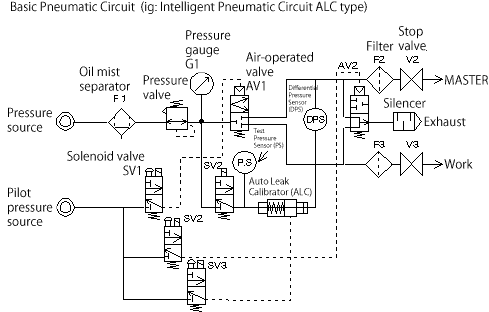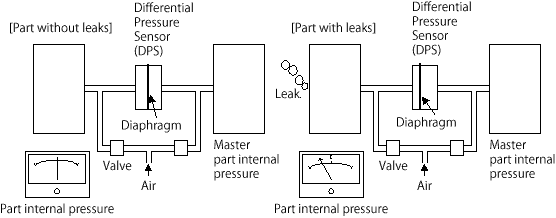An air leak tester works by pressurizing a part or system and then measuring any pressure drop to detect leaks. This is done using sensors and specialized equipment to pinpoint the location and size of leaks.
Air leak testers are crucial in industries like automotive, aerospace, and manufacturing, where ensuring the integrity of components and systems is paramount. By accurately identifying leaks, these testers help maintain quality control, improve safety, and reduce waste. They come in various types, from simple handheld devices to complex automated systems, each tailored to the specific needs of the applications they serve.
Understanding how air leak testers work is essential to appreciate their role in maintaining the efficiency and reliability of various products and systems.
Basic Principles
An air leak tester works on the basic principle of measuring the flow of air to detect any leaks in the system. It uses pressurized air to identify any unwanted air leakage in various components such as valves, tanks, and pipes.
This process helps ensure the efficiency and safety of the equipment.
| Basic Principles | ||
| – Air leak tester works using pressure decay method, which measures air pressure changes. | – Vacuum decay method detects leaks by monitoring vacuum levels in a closed system. | – Mass flow method calculates leaks by measuring mass flow rate of air escaping. |

Credit: fukuda-us.com
Components Of An Air Leak Tester
In an air leak tester, the components responsible for its functioning include a pressure source, pressure regulator, test chamber, and a pressure sensor. The pressure source is the input for generating the necessary pressure for the testing process. It supplies the required air pressure to the system. The pressure regulator ensures the appropriate pressure level is maintained by controlling the flow of air from the pressure source. The test chamber is where the object being tested is placed. It keeps the object isolated and allows the air pressure to build up inside. The pressure sensor measures the pressure within the test chamber and provides feedback to determine if any leaks are present. Together, these components work harmoniously to accurately detect and analyze air leaks, ensuring the quality and safety of various products.
Types Of Air Leak Testers
Air Leak Testers are used to check for any leakage in a product or component. There are different types of air leak testers such as pressure decay testers, vacuum decay testers, and mass flow testers. Pressure decay testers measure the change in pressure to detect leaks. Vacuum decay testers work by creating a vacuum in the part and then monitoring for pressure changes. Mass flow testers use a flow sensor to measure the leakage rate. Each type of tester has its own unique advantages and can be used depending on the specific requirements of the product being tested. Understanding the working principle of these top 10 refrigerant air leak detector testers can greatly enhance quality control in manufacturing processes.
Application Areas
Air leak testers are widely used in various industries including the automotive industry, medical devices, and electronics industry. In the automotive industry, these testers are used to check for leaks in components such as engine blocks, transmissions, and fuel systems. In the medical devices sector, air leak testers ensure the safety and reliability of products such as respirators and infusion pumps. The electronics industry utilizes air leak testers to verify the integrity of sealed electronic components and devices.
Advantages Of Air Leak Testing
Advantages of Air Leak Testing:
Air leak testing is a crucial step in ensuring the quality of products. It helps identify any leaks or faults in the sealing of products, preventing potential issues that could lead to product recalls. By using an air leak tester, manufacturers can confirm that their products meet the required standards and specifications set by the industry.
One of the key advantages of air leak testing is that it helps in ensuring product quality. It allows manufacturers to identify any air leaks in the product’s packaging or components, which can lead to product failure or compromised performance. By detecting and fixing these leaks, manufacturers can guarantee that their products meet the desired quality standards.
In addition, air leak testing plays a vital role in preventing product recalls. Detecting and rectifying potential leaks before the products reach the market is essential to avoid costly recalls and damage to the brand’s reputation. By implementing air leak testing as part of the quality control process, manufacturers can significantly reduce the risk of product recalls.
Moreover, air leak testing is necessary for compliance with industry standards. Various industries have specific regulations and guidelines regarding the airtightness of products. Manufacturers must ensure their products meet these standards to maintain compliance and avoid any legal consequences that may arise due to non-compliance.
Challenges In Air Leak Testing
Air leak testing poses various challenges, such as detecting small leaks and ensuring accurate results. The functionality of an air leak tester relies on its ability to pressurize and measure leaks in sealed components or systems. It is crucial to understand how these testers work to overcome these challenges effectively.
| Air leak testers work by detecting leaks in airtight products. |
| Challenges: |
| Small leak detection: Detecting tiny leaks poses significant challenges. |
| Variations: Test conditions must be consistent for accurate results. |
| Integration: Seamless integration with production lines is vital for efficiency. |
Future Trends In Air Leak Testing
Discover the latest advancements in air leak testing technology. Learn how air leak testers function and their pivotal role in ensuring product quality and performance for the future. Stay ahead by understanding the workings of air leak detection systems for enhanced efficiency.
| Automation and robotics: Air leak testers are increasingly incorporating automation and robotics to streamline the testing process. |
| IoT integration: Integration with IoT enables real-time monitoring and data analysis for efficient air leak detection. |
| Enhanced sensitivity technology: Advancements in technology have led to improved sensitivity in detecting even the smallest air leaks. |

Credit: www.cosmo-k.co.jp
Frequently Asked Questions For How Air Leak Tester Works
How Does An Air Leak Tester Work?
An air leak tester works by pressurizing a part and measuring the pressure drop to detect any leaks.
What Are The Benefits Of Using An Air Leak Tester?
Using an air leak tester ensures product quality, reduces waste, and improves safety in various industries.
What Types Of Industries Can Benefit From An Air Leak Tester?
Industries such as automotive, electronics, medical devices, and packaging can benefit from using an air leak tester.
Conclusion
Air leak testers are innovative devices that play a crucial role in ensuring the integrity of various products. By detecting and analyzing leaks with precision and accuracy, these testers help to enhance quality control processes in industries such as automotive, pharmaceutical, and electronics.
With their advanced technology and ease of use, air leak testers provide an efficient solution for identifying and resolving leaks promptly, ultimately leading to improved product performance and customer satisfaction.
